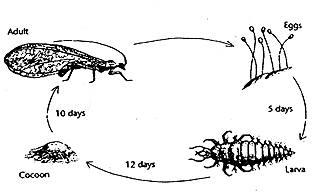|
A Comprehensive Guide to Safe Biological Pest Control |
* Ask a Question * |
| Home About FAQ Quick Reference | |
NATURAL PEST CONTROL WITH GREEN LACEWINGS
Green lacewings is a general predator, as soon as the green lacewing eggs hatch the hungry larvae will eat aphids, mealybugs, scale, spider mites, thrips, whiteflies and other slow moving insects. To order Green lacewing eggs and get pricing and information, Please order Green lacewings for sale at Buglogical.com
 THE "APHID LION" After a few days, the eggs hatch and tiny larvae emerge which are also known
as" aphid lions" because of their voracious appetite. The larvae have sickle-shaped jaws (mandibles) with which they pierce prey and suck out body juices. Adults have chewing mouthparts. Adults are poor fliers, active at night and feed on pollen, nectar and honeydew (the exudate of aphids and other sucking insects). Some species are predaceous as adults to a limited extent. The larvae, called "aphid lions", are extremely carnivorous and predaceous on many soft-bodied insects and mites, including insect eggs, thrips, mealybugs, immature whiteflies and small caterpillars. Larvae have sickle-shaped jaws that contain tubes with which they can inject prey with a paralyzing venom and then suck out the body fluids. They can consume over 200 aphids or other prey per week. There is no other better predator known to consume vast quantities of eggs and the soft bodies of aphids, mealy-bugs, spider mites, leafhopper nymphs, caterpillar eggs, scales, thrips, and white-flies. The lacewing larvae attack the eggs of most pests and, if the bodies are not to hard and fast moving, will attack the adult pest stage as well.
THE "APHID LION" After a few days, the eggs hatch and tiny larvae emerge which are also known
as" aphid lions" because of their voracious appetite. The larvae have sickle-shaped jaws (mandibles) with which they pierce prey and suck out body juices. Adults have chewing mouthparts. Adults are poor fliers, active at night and feed on pollen, nectar and honeydew (the exudate of aphids and other sucking insects). Some species are predaceous as adults to a limited extent. The larvae, called "aphid lions", are extremely carnivorous and predaceous on many soft-bodied insects and mites, including insect eggs, thrips, mealybugs, immature whiteflies and small caterpillars. Larvae have sickle-shaped jaws that contain tubes with which they can inject prey with a paralyzing venom and then suck out the body fluids. They can consume over 200 aphids or other prey per week. There is no other better predator known to consume vast quantities of eggs and the soft bodies of aphids, mealy-bugs, spider mites, leafhopper nymphs, caterpillar eggs, scales, thrips, and white-flies. The lacewing larvae attack the eggs of most pests and, if the bodies are not to hard and fast moving, will attack the adult pest stage as well.
 Use lacewing eggs, larvae for greenhouses and gardens. Larvae will only feed for 1-3 weeks before they become adults (eating only nectar and honeydew).
Use approximately 10 lacewing eggs, larvae per plant or 1000 eggs per 200 square feet. After a few days, the eggs hatch and tiny larvae emerge. The larvae are gray-brown in color and newly hatch are very tiny. Similar in appearance to an alligator with pincers, the lacewing larvae vigorously attacks its prey, injects a paralyzing venom, and draws out the body fluids of its helpless victim. Depending on climate conditions, the adults will live for about four to six weeks, feeding only on nectar, pollen and honeydew. If these food sources are not avalable, it will simply leave the area and lay its eggs elsewhere.
Use lacewing eggs, larvae for greenhouses and gardens. Larvae will only feed for 1-3 weeks before they become adults (eating only nectar and honeydew).
Use approximately 10 lacewing eggs, larvae per plant or 1000 eggs per 200 square feet. After a few days, the eggs hatch and tiny larvae emerge. The larvae are gray-brown in color and newly hatch are very tiny. Similar in appearance to an alligator with pincers, the lacewing larvae vigorously attacks its prey, injects a paralyzing venom, and draws out the body fluids of its helpless victim. Depending on climate conditions, the adults will live for about four to six weeks, feeding only on nectar, pollen and honeydew. If these food sources are not avalable, it will simply leave the area and lay its eggs elsewhere.
Green lacewings are predators found in most environments. Several species of Chrysoperla and Chrysopa are important predators. The common green lacewing occurs throughout North America, while other species are more restricted in distribution. The light green adult has long, slender antennae, golden eyes, and large, veined, gauze-like wings that are 1/2 - 1/3 inches long. It is a slow-flying, nocturnal insect that feeds on nectar and pollen, and it emits a foul-smelling fluid from special glands if captured. The female lacewing lays eggs usually in groups on leaves, each egg held away from the leaf surface on the end of a slender stalk. A female lays up to 300 eggs over a period of 3-4 weeks, but often it does not survive that long in the field.
The larva, commonly called an aphid lion, resembles a green-gray alligator with mouthparts like ice tongs. An aphid lion seizes and punctures its prey with long, sickle-shaped jaws, injects paralyzing venom, and sucks out the body fluids. After feeding and growing to 1/2 inch in length during a 2-3 week period, the larva spins a spherical, white silken cocoon in which it pupates. The adult emerges in about 5 days through a round hole that it cuts in the top of the cocoon. It overwinters as a pupa within its cocoon or as an adult, depending on the species.
The green lacewing larvae are a voracious feeder and can consume up to 200 aphids or other prey per week. In addition to aphids, it will eat mites and a wide variety of soft-bodied insects, including insect eggs, thrips, mealybugs, immature whiteflies, and small caterpillars. Aphid lions will also consume each other if no other prey is available.
Green lacewings are available from Buglogical Control Systems generally offered as eggs. The released green lacewings larvae move around a lot and will travel 80-100 feet in search of prey. Once their food source is exhausted they will leave the area. The predatory larvae feed for 2-3 weeks before they become adults. The adults must have a source of nectar, pollen, or honeydew to feed on in the general vicinity of the pest area to stimulate egg laying, or they will leave. Providing an adequate food supply and suitable adult habitat can contribute to lacewings remaining and reproducing in the crop. Additional releases can provide a continuous supply of larvae if adults do not stay and reproduce.
The number of lacewings needed for effective control depends on the pest population and climatic conditions. For control of moderate aphid infestations in home gardens, 5-10 lacewing eggs per plant or 1,000 eggs per 200 square feet are recommended. General release recommendations for most crop situations start at 5,000 per acre for each application, but much higher rates may be necessary. Two or three successive releases made at two week intervals are better than a single release. Suppliers usually make recommendations based on specific situations. These insects are extremely effective under certain conditions, especially in protected or enclosed areas such as a greenhouse, but they may fail to survive and provide control when conditions are not favorable.
ConservationBecause young larvae are susceptible to dessication, they may need a source of moisture. Adult lacewings need nectar or honeydew as food before egg laying and they also feed on pollen. Therefore, plantings should include flowering plants, and a low level of aphids should be tolerated. Artificial foods and honeydew substitutes are available commercially and have been used to enhance the number and activity of adult lacewings. These products may provide sufficient nutrients to promote egg laying, but they cannot counter the dispersal behavior of newly emerged adult lacewings.
Green lacewing eggs are shipped in bran or rice hulls and packed with moth eggs for food. The best time to release is early morning or later afternoon. Never release in the heat of the day. For best results, immediate use is advised however, when release is inconvenient, they can be stored in the refrigerator for up to 48 hours. Warmer temperatures will speed up their emergence and newly hatched lacewing larvae are hungry and will cannibalize each other if they are not released quickly.
If the infestation has not been arrested after 5 to 7 days, additional releases may be necessary. When releasing on a regular schedule, change the release sites within the target area to get maximum coverage.
